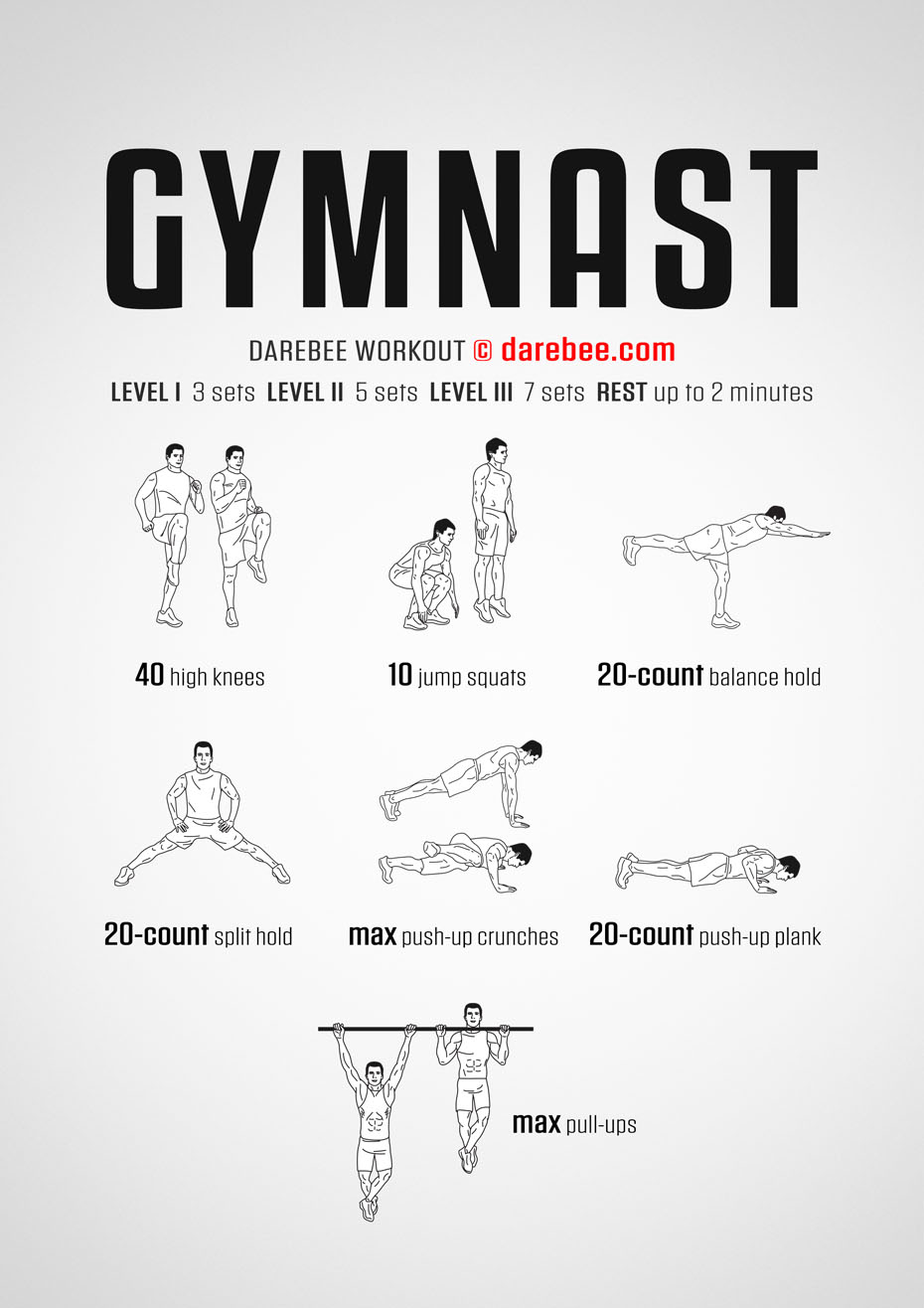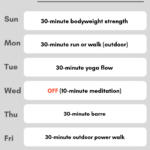Gymnastics demands strength, flexibility, and precision. Training at home can be effective and convenient.
Embracing a gymnast workout at home offers a unique chance to maintain and develop skills outside a gym setting. With the right exercises, anyone can build strength, improve balance, and enhance flexibility right from their living room. This approach not only saves time but also allows personalization of routines to fit individual needs.
It’s about creating a space where you can focus on perfecting moves and building physical resilience. Whether you’re a seasoned gymnast or a beginner, home workouts can be an excellent way to stay active and improve your skills. Let’s explore how you can integrate gymnastics into your daily routine, right at home.

Credit: blog.workoutnotepad.co
Introduction To Home Workouts
Welcome to the world of home workouts, where your living room becomes your personal gym and your schedule is your own. Whether you’re a budding gymnast or simply looking to enhance your fitness routine, working out at home offers flexibility and convenience. You can skip the commute, wear what you want, and exercise on your own terms.
Benefits Of Exercising At Home
Exercising at home saves you time and money. No need for a gym membership or travel expenses. You get to work out whenever it suits you. Feel like stretching at midnight? Go for it.
Home workouts allow you to focus on your personal goals without distractions. It’s just you and your mat. You control the environment and can create a space that motivates you. Maybe it’s a favorite playlist or a motivational poster.
Have you ever felt self-conscious at the gym? At home, there’s no judgment. You can try new exercises and perfect your form without worrying about who’s watching. It’s your safe space to explore and grow.
Essential Equipment For Gymnasts
Starting with the basics, a yoga mat is essential. It provides cushioning and support during floor exercises. You might want to invest in a thicker mat for extra comfort. It’s perfect for exercises like planks and push-ups.
Resistance bands are small but mighty tools. They help build strength and flexibility. You can use them for various exercises like leg lifts and arm stretches. They’re affordable and easy to store.
Consider a balance beam for practicing gymnastics skills. A portable beam can fit easily in your home. It’s great for working on balance and coordination. If space is limited, a floor beam can be a good alternative.
Lastly, a set of dumbbells can enhance your workout. They add resistance to exercises, helping build muscle strength. Start with lighter weights and gradually increase as you get stronger.
Do you have a favorite piece of equipment that you swear by? Share your thoughts and let’s help each other create the ultimate home gym setup!
Creating A Home Gym Space
Transform your living area into a fitness zone for gymnasts. Create a comfortable space with mats and sturdy equipment. Enjoy doing routines and exercises at home. Stay fit and flexible without leaving your house.
Creating a home gym space is essential for effective workouts. It provides convenience and flexibility. Gymnasts can practice and improve skills anytime. A dedicated space ensures focus and safety. Here’s how to set up your perfect home gym.Choosing The Right Area
Pick a location with enough space to move freely. Look for an area with a flat surface. A room with good ventilation is a bonus. Natural light can enhance your workout mood. Avoid spaces with clutter or distractions. Ensure your chosen spot is accessible and inviting.Safety Considerations
Safety should be your top priority. Use non-slip mats to prevent falls. Keep the area free from sharp objects. Ensure there is enough room to perform moves safely. Proper lighting helps avoid accidents. Regularly check equipment for wear and tear. Prioritize safety to make workouts enjoyable and risk-free.Warm-up Routines
Starting any workout with a proper warm-up is crucial. It prepares your body for the exercises ahead. Gymnast at home workout routines require attention to warm-up. This helps prevent injuries and enhances performance. Let’s dive into essential warm-up routines.
Dynamic Stretches
Dynamic stretches are key to a gymnast’s warm-up. They involve moving parts of your body with controlled motion. This increases blood flow to muscles. Arm circles are a great start. Swing your arms in circles forward and backward. Leg swings also help. Stand on one leg and swing the other back and forth. Repeat for both legs. Dynamic stretches prepare muscles for intense activity.
Joint Mobility Exercises
Joint mobility exercises focus on moving joints through their full range. This keeps joints flexible and ready for action. Begin with neck rotations. Slowly turn your head in circles. Follow with shoulder shrugs. Lift shoulders to ears and lower them. Wrist circles are essential for gymnasts. Rotate wrists in both directions. Joint mobility exercises improve flexibility and reduce strain.

Credit: gymnasticshq.com
Strength Training Exercises
Strength training is essential for gymnasts, enhancing power and control. These exercises can be done at home with minimal equipment. From bodyweight workouts to resistance band techniques, they build muscle and improve flexibility. Let’s explore effective methods to boost your gymnastics performance.
Bodyweight Workouts
Bodyweight exercises are perfect for developing strength. They require no special equipment. Push-ups target the chest, shoulders, and arms. Squats build leg power and stability. Try plank holds for core strength and endurance. Lunges enhance balance and coordination. These simple moves can transform your workout routine. Consistency is key. Focus on form and control.
Resistance Band Techniques
Resistance bands offer versatile strength training options. They are portable and easy to use. Use them for squats to increase resistance and power. Bicep curls with bands enhance arm strength. Band rows target the back muscles effectively. Try tricep extensions for arm endurance. Resistance bands help in building lean muscle. Adjust the band’s tension for varied intensity.
Flexibility And Balance
Finding flexibility and balance is key for gymnasts working out at home. Simple exercises enhance core strength and coordination. Regular practice ensures improvement without needing a full gym setup.
Flexibility and balance are essential skills for any gymnast, whether you’re a beginner or a seasoned athlete. These skills help you perform complex movements with grace and precision. Training at home can be just as effective, and it doesn’t require any fancy equipment. By focusing on improving these two aspects, you can enhance your overall performance and reduce the risk of injuries. When I started my home workouts, I was surprised by how much my flexibility and balance improved just by dedicating a little time each day. You can achieve the same by integrating simple exercises into your routine. ###Yoga For Gymnasts
Yoga is an excellent way to boost your flexibility. It helps lengthen muscles and improve joint mobility. Try incorporating poses like the Downward Dog and Cobra into your daily routine. These poses stretch your entire body and target key muscle groups used in gymnastics. Holding each pose for 30 seconds can make a significant difference. You’ll notice increased flexibility and better posture over time. Plus, yoga also aids in calming your mind, which is beneficial before a big competition. ###Balance Drills
Improving balance is crucial for executing flawless routines. Simple exercises can make a huge impact. Practice standing on one leg while brushing your teeth or waiting for your coffee to brew. This helps improve your stability. For a more challenging drill, try the Tightrope Walk in your living room. Walk heel-to-toe in a straight line with your arms outstretched. This exercise strengthens your core and enhances your balance. Remember, consistent practice is key. Have you ever noticed how quickly a child learns to balance on a bike? You can train your balance just as effectively by staying consistent with these drills. What small changes can you make to improve your balance today? Embrace these exercises as part of your daily routine. You’ll soon see the benefits in your gymnastics performances.Cardio Workouts
Cardio workouts are essential for gymnasts training at home. They improve endurance and overall fitness. These exercises can be done without equipment. They keep your heart healthy and enhance stamina. Cardio workouts can fit any schedule, making them convenient. Below are some effective cardio routines for gymnasts.
High-intensity Interval Training
High-Intensity Interval Training (HIIT) is quick and powerful. It involves short bursts of intense exercise. These bursts are followed by rest periods. HIIT can be done in 20 minutes or less. It burns calories fast and increases heart rate. Jumping jacks and burpees are great examples. They engage multiple muscle groups efficiently.
Dance Cardio
Dance cardio is fun and energetic. It combines dancing with aerobic movements. These workouts boost mood and fitness simultaneously. Popular dance styles include Zumba and hip-hop. They improve coordination and rhythm. Dance cardio is suitable for all fitness levels. It can be adjusted to match your pace.
Recovery And Rest Days
Gymnastics demands strength, flexibility, and precision. But every intense workout needs balance. Recovery and rest days play a crucial role. These days help your body heal and grow stronger. Skipping rest can lead to fatigue and injury. Proper recovery boosts performance and keeps your training effective.
Importance Of Rest
Rest days are essential for muscle repair. Muscles grow during rest, not workouts. Without rest, your muscles can’t rebuild. This can slow down your progress. Rest also prevents burnout. It keeps your mind fresh and motivated. Your body needs time to adapt to new routines. Rest days allow for this adaptation.
Active Recovery Ideas
Active recovery is a gentle approach to rest. It involves light activities that aid recovery. Try walking or cycling at a relaxed pace. Yoga can help stretch and relax your muscles. Swimming is another great option. It supports your body and eases muscle tension. These activities keep blood flowing and support healing.
Tracking Progress
Tracking progress is vital in any gymnast’s home workout journey. It helps you stay motivated and focused. By keeping track of your achievements, you can see how far you’ve come. This encourages consistent improvement and dedication. Let’s explore how you can track progress effectively.
Setting Fitness Goals
Start with clear fitness goals. Decide what you want to achieve in your workouts. Are you aiming to enhance flexibility or strength? Maybe you’re working on balance or endurance. Write these goals down. Make them specific and time-bound. This will give your workouts a clear direction.
Monitoring Improvements
Keep a workout journal or use an app to note changes. Record your reps, sets, and any new skills. Use photos or videos to capture your form over time. Review them to see visible progress. Check your flexibility by measuring reach or splits. Track your strength with weights or resistance bands. Regularly assess your balance through specific exercises.
Staying Motivated
Staying motivated during home workouts can be challenging. Without a coach’s guidance, it’s easy to lose focus. Yet, maintaining motivation is crucial for success in gymnastics at home. How do you keep that spark alive? Let’s explore some helpful strategies.
Creating A Workout Schedule
A structured workout schedule helps keep you on track. Decide the days and times you’ll exercise. Stick to this routine like a professional gymnast. Consistency builds habits and keeps motivation high. Break your schedule into manageable chunks. Short sessions are less daunting and easier to complete. Track your progress. Seeing improvement boosts your morale and drives you forward.
Inspiring Success Stories
Success stories inspire and motivate. Read about gymnasts who trained at home and achieved their goals. Their journeys show that dedication pays off. Watch videos of athletes overcoming challenges. Their determination ignites a passion within you. Share your progress with friends or online communities. Positive feedback from others fuels motivation and encourages perseverance.

Credit: gymnasticshq.com
Conclusion And Next Steps
As you wrap up your gymnast at-home workout journey, it’s crucial to reflect on your progress and plan your next steps. Transitioning from following a structured routine to crafting your own workout plan can feel liberating. Take this opportunity to assess your achievements and set new goals to keep your fitness journey exciting.
Evaluating Your Fitness Journey
Reflect on the milestones you’ve reached. Have you improved your flexibility or mastered a new skill? Celebrating small victories keeps you motivated.
Consider keeping a journal to track your progress. Note changes in your strength, endurance, and flexibility. This helps you visualize growth over time.
Ask yourself how you feel physically and mentally. Are you more confident in your abilities? Self-awareness fosters better decision-making for future workouts.
Planning Future Workouts
Set realistic goals based on your evaluations. Do you want to increase your workout frequency or try new exercises? Clear objectives guide your training.
Research new techniques or routines that interest you. Incorporating variety keeps workouts fresh and engaging.
Plan a balanced schedule. Mix strength training, flexibility, and cardio sessions. This ensures overall development and prevents burnout.
Seek advice from online communities or fellow enthusiasts. Sometimes, others’ experiences can offer fresh perspectives and ideas.
What will your next achievement be? Challenge yourself to reach new heights and share your goals with friends or family. Accountability is a powerful motivator.
Remember, your fitness journey is unique. Embrace each step, adapt when needed, and most importantly, enjoy the process.
Frequently Asked Questions
How Do Gymnasts Train At Home?
Gymnasts train at home by practicing stretching, strength exercises, and routines. Use mats for safety and avoid hard surfaces. Set specific goals and track progress. Online tutorials can provide guidance and enhance skills. Maintain consistent practice to improve flexibility, balance, and technique.
Should Gymnasts Practice At Home?
Yes, gymnasts can practice at home. Home practice enhances skills and flexibility. Ensure a safe space and proper guidance.
Is 14 Years Old Too Late To Start Gymnastics?
Starting gymnastics at 14 is not too late. Many teens begin at this age and excel. Dedication and practice are key. Gymnastics improves flexibility, strength, and discipline. Age should not deter your passion or goals. Embrace the challenge and enjoy the journey.
How Can I Become Flexible Like A Gymnast At Home?
Start with daily stretching routines. Focus on splits, backbends, and shoulder exercises. Incorporate yoga and Pilates for flexibility. Use videos for guidance and progress tracking. Prioritize consistency and patience for optimal results.
Conclusion
Home workouts can be fun and effective for gymnasts. You don’t need fancy equipment. Just commitment and creativity. Regular practice builds strength and flexibility. It also boosts confidence. Stay consistent and see progress. Enjoy the journey, not just the results.
Fitness grows with patience and time. Keep challenging yourself. Push your limits safely. Celebrate small victories. Each day is a new chance. Make the most of it. Stay motivated and focused. Your home can be your gym. Fitness is possible anywhere.
Stay active and healthy. Keep moving forward. Your body will thank you.





